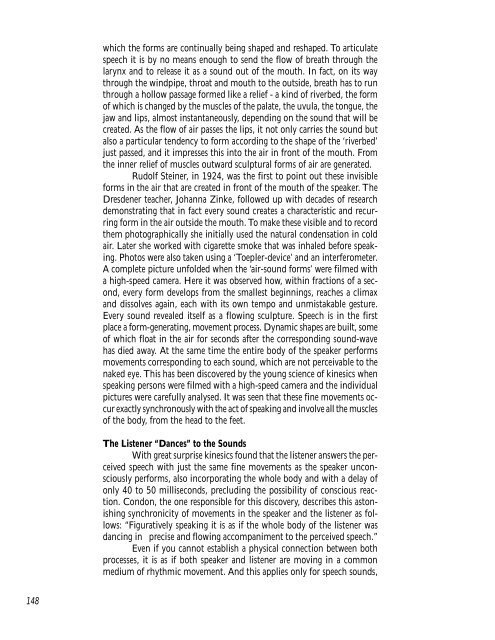Colloquium on English - Research Institute for Waldorf Education
Colloquium on English - Research Institute for Waldorf Education
Colloquium on English - Research Institute for Waldorf Education
You also want an ePaper? Increase the reach of your titles
YUMPU automatically turns print PDFs into web optimized ePapers that Google loves.
148<br />
which the <strong>for</strong>ms are c<strong>on</strong>tinually being shaped and reshaped. To articulate<br />
speech it is by no means enough to send the flow of breath through the<br />
larynx and to release it as a sound out of the mouth. In fact, <strong>on</strong> its way<br />
through the windpipe, throat and mouth to the outside, breath has to run<br />
through a hollow passage <strong>for</strong>med like a relief - a kind of riverbed, the <strong>for</strong>m<br />
of which is changed by the muscles of the palate, the uvula, the t<strong>on</strong>gue, the<br />
jaw and lips, almost instantaneously, depending <strong>on</strong> the sound that will be<br />
created. As the flow of air passes the lips, it not <strong>on</strong>ly carries the sound but<br />
also a particular tendency to <strong>for</strong>m according to the shape of the ‘riverbed’<br />
just passed, and it impresses this into the air in fr<strong>on</strong>t of the mouth. From<br />
the inner relief of muscles outward sculptural <strong>for</strong>ms of air are generated.<br />
Rudolf Steiner, in 1924, was the first to point out these invisible<br />
<strong>for</strong>ms in the air that are created in fr<strong>on</strong>t of the mouth of the speaker. The<br />
Dresdener teacher, Johanna Zinke, followed up with decades of research<br />
dem<strong>on</strong>strating that in fact every sound creates a characteristic and recurring<br />
<strong>for</strong>m in the air outside the mouth. To make these visible and to record<br />
them photographically she initially used the natural c<strong>on</strong>densati<strong>on</strong> in cold<br />
air. Later she worked with cigarette smoke that was inhaled be<strong>for</strong>e speaking.<br />
Photos were also taken using a ‘Toepler-device’ and an interferometer.<br />
A complete picture unfolded when the ‘air-sound <strong>for</strong>ms’ were filmed with<br />
a high-speed camera. Here it was observed how, within fracti<strong>on</strong>s of a sec<strong>on</strong>d,<br />
every <strong>for</strong>m develops from the smallest beginnings, reaches a climax<br />
and dissolves again, each with its own tempo and unmistakable gesture.<br />
Every sound revealed itself as a flowing sculpture. Speech is in the first<br />
place a <strong>for</strong>m-generating, movement process. Dynamic shapes are built, some<br />
of which float in the air <strong>for</strong> sec<strong>on</strong>ds after the corresp<strong>on</strong>ding sound-wave<br />
has died away. At the same time the entire body of the speaker per<strong>for</strong>ms<br />
movements corresp<strong>on</strong>ding to each sound, which are not perceivable to the<br />
naked eye. This has been discovered by the young science of kinesics when<br />
speaking pers<strong>on</strong>s were filmed with a high-speed camera and the individual<br />
pictures were carefully analysed. It was seen that these fine movements occur<br />
exactly synchr<strong>on</strong>ously with the act of speaking and involve all the muscles<br />
of the body, from the head to the feet.<br />
The Listener “Dances” to the Sounds<br />
With great surprise kinesics found that the listener answers the perceived<br />
speech with just the same fine movements as the speaker unc<strong>on</strong>sciously<br />
per<strong>for</strong>ms, also incorporating the whole body and with a delay of<br />
<strong>on</strong>ly 40 to 50 millisec<strong>on</strong>ds, precluding the possibility of c<strong>on</strong>scious reacti<strong>on</strong>.<br />
C<strong>on</strong>d<strong>on</strong>, the <strong>on</strong>e resp<strong>on</strong>sible <strong>for</strong> this discovery, describes this ast<strong>on</strong>ishing<br />
synchr<strong>on</strong>icity of movements in the speaker and the listener as follows:<br />
“Figuratively speaking it is as if the whole body of the listener was<br />
dancing in precise and flowing accompaniment to the perceived speech.”<br />
Even if you cannot establish a physical c<strong>on</strong>necti<strong>on</strong> between both<br />
processes, it is as if both speaker and listener are moving in a comm<strong>on</strong><br />
medium of rhythmic movement. And this applies <strong>on</strong>ly <strong>for</strong> speech sounds,

















